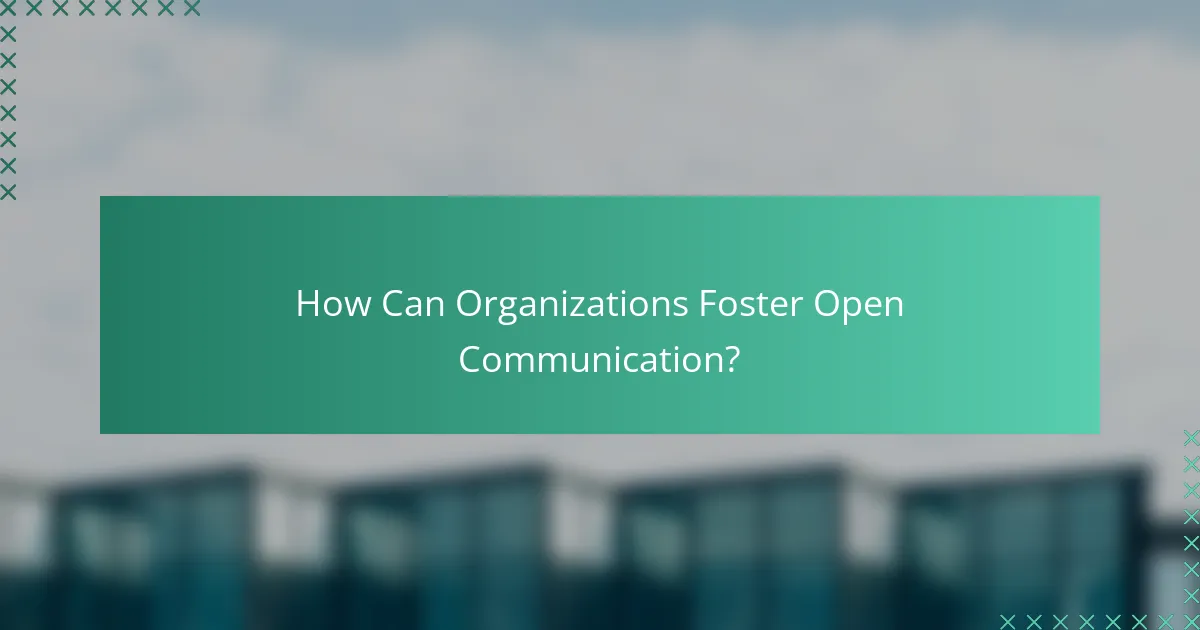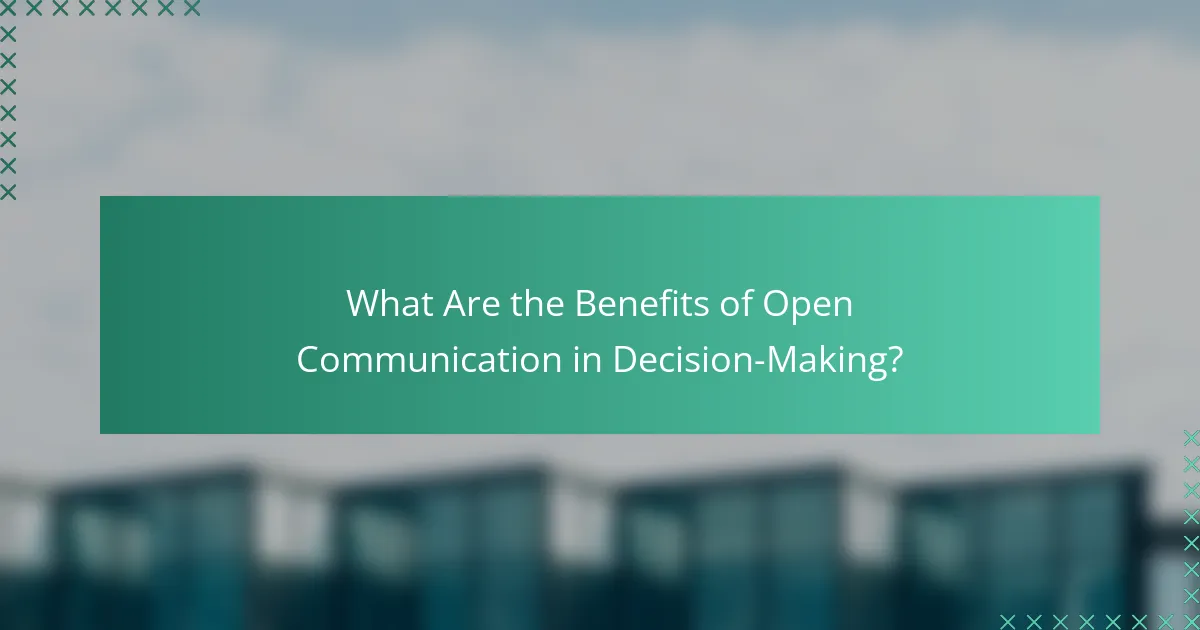A culture of open communication in decision-making is characterized by an environment where all team members can freely express their thoughts and opinions, promoting transparency and inclusivity. This article outlines the significance of fostering such a culture, highlighting its benefits, including enhanced collaboration, trust, and employee engagement. Key strategies for implementing open communication include encouraging feedback, conducting regular meetings, utilizing anonymous surveys, and training leaders in effective communication skills. The article also emphasizes that organizations prioritizing open communication experience improved decision-making quality, higher productivity, and better employee retention rates, ultimately leading to greater organizational effectiveness and adaptability.

What is a Culture of Open Communication in Decision-Making?
A culture of open communication in decision-making is an environment where all members feel free to express their thoughts and opinions. This culture encourages transparency and inclusivity in discussions. It allows for diverse perspectives to be considered in the decision-making process. Open communication leads to better collaboration and trust among team members. Research indicates that organizations with this culture experience higher employee engagement and satisfaction. A study by the Institute for Corporate Productivity found that open communication can improve decision-making speed and quality. This culture fosters innovation by allowing ideas to flow freely. Overall, it enhances organizational effectiveness and adaptability.
Why is Open Communication Important in Decision-Making?
Open communication is important in decision-making because it fosters collaboration and trust among team members. When individuals share their thoughts openly, diverse perspectives emerge. This diversity leads to more informed and effective decisions. Studies show that teams with open communication are 25% more productive. Additionally, open dialogue reduces misunderstandings and conflict, promoting a healthier work environment. Transparency in communication encourages accountability, ensuring everyone understands their roles. Overall, open communication enhances engagement and commitment to decisions made.
How does Open Communication impact team dynamics?
Open communication significantly enhances team dynamics. It fosters trust among team members. When individuals feel safe to express their thoughts, collaboration improves. Clear communication reduces misunderstandings, leading to more effective problem-solving. Research indicates that teams with open communication report higher satisfaction levels. According to a study by McKinsey, effective communication can improve team performance by 25%. Open dialogue encourages diverse perspectives, which enriches decision-making processes. In summary, open communication is vital for cohesive and productive team dynamics.
What role does transparency play in decision-making?
Transparency plays a critical role in decision-making by fostering trust and accountability. When decision-makers are transparent, stakeholders can understand the rationale behind choices. This clarity reduces uncertainty and encourages stakeholder engagement. Transparency also enhances collaboration among team members. Research shows that organizations with transparent decision-making processes have higher employee satisfaction. For instance, a study by the Harvard Business Review found that transparency leads to better performance outcomes. This highlights the importance of open communication in effective decision-making.
What are the Key Components of Open Communication?
The key components of open communication are clarity, honesty, active listening, and feedback. Clarity ensures that messages are understood without ambiguity. Honesty builds trust among participants, fostering a safe environment for sharing ideas. Active listening involves paying full attention to the speaker, which enhances understanding and collaboration. Feedback is essential for improving communication processes and ensuring that messages are received as intended. According to a study by the Harvard Business Review, organizations that prioritize these components see increased employee engagement and better decision-making outcomes.
How do trust and respect influence communication?
Trust and respect significantly enhance communication effectiveness. When individuals trust each other, they are more likely to share information openly. This openness fosters collaboration and reduces misunderstandings. Respect ensures that all participants feel valued and heard. Research indicates that teams with high trust levels experience improved communication flow. According to a study by the Institute for Corporate Productivity, organizations with a culture of trust report 50% higher employee engagement. This engagement leads to better decision-making and problem-solving. Thus, trust and respect create a positive communication environment, essential for effective teamwork.
What tools can facilitate open communication?
Tools that can facilitate open communication include collaboration platforms, messaging apps, video conferencing software, and feedback tools. Collaboration platforms like Slack or Microsoft Teams allow team members to share information in real-time. Messaging apps, such as WhatsApp or Telegram, enable quick and informal communication. Video conferencing software, like Zoom or Google Meet, supports face-to-face discussions regardless of location. Feedback tools, such as SurveyMonkey or Google Forms, gather input from team members effectively. These tools enhance transparency and encourage participation in decision-making processes.

How Can Organizations Foster Open Communication?
Organizations can foster open communication by creating an inclusive environment. This involves encouraging employee feedback and actively listening to their concerns. Regular team meetings can be implemented to discuss ideas and issues openly. Utilizing anonymous surveys can also help gather honest opinions from staff. Training leaders in effective communication skills is essential for promoting transparency. Setting clear communication channels ensures that information flows smoothly. Recognizing and rewarding open communication behaviors reinforces their importance. Research shows that organizations with strong communication practices have higher employee satisfaction and productivity.
What Strategies Promote Open Communication in Teams?
Strategies that promote open communication in teams include establishing trust, encouraging feedback, and fostering an inclusive environment. Trust enables team members to share ideas without fear of judgment. Regular feedback sessions allow for continuous improvement and open dialogue. An inclusive environment ensures all voices are heard, enhancing collaboration. Additionally, utilizing collaborative tools can facilitate real-time communication. Research shows that teams with strong communication practices are 25% more productive. These strategies create a culture where open communication thrives, leading to better decision-making outcomes.
How can leadership set the tone for open dialogue?
Leadership can set the tone for open dialogue by modeling transparent communication. Leaders should actively encourage feedback and questions from team members. This creates an environment where individuals feel valued and heard. Regularly scheduled meetings can provide a platform for open discussions. Leaders should also practice active listening to demonstrate respect for diverse opinions. Establishing clear communication channels further supports open dialogue. Additionally, leaders must be approachable and available to their teams. Research shows that organizations with open communication see higher employee engagement and satisfaction.
What training methods enhance communication skills?
Effective training methods that enhance communication skills include role-playing, active listening exercises, and feedback sessions. Role-playing allows participants to practice real-life scenarios in a controlled environment. This method helps individuals understand different perspectives and improve their responses. Active listening exercises focus on developing the ability to fully concentrate, understand, and respond thoughtfully. This fosters better interpersonal interactions. Feedback sessions provide opportunities for individuals to receive constructive criticism on their communication style. Research indicates that these methods significantly improve both verbal and non-verbal communication skills. According to a study by the International Journal of Business Communication, organizations that implement these training methods see a 30% increase in effective communication among employees.
What Challenges Might Organizations Face?
Organizations may face resistance to change when fostering a culture of open communication. Employees often feel comfortable in established routines. This resistance can hinder the implementation of new communication practices. Additionally, a lack of trust among team members can create barriers. Trust is essential for open dialogue and sharing of ideas. Another challenge is the potential for miscommunication. Misunderstandings can arise without clear communication channels. Furthermore, organizations may struggle with hierarchical structures. These structures can stifle open communication and feedback. Lastly, time constraints can limit opportunities for discussion. Busy schedules often prioritize tasks over communication efforts.
How can resistance to change affect communication culture?
Resistance to change can significantly hinder communication culture. It creates an environment of distrust among team members. When individuals resist change, they often withhold information. This leads to a lack of transparency in communication. Consequently, misunderstandings and misinterpretations can arise. Research shows that organizations with high resistance to change experience lower employee engagement. This disengagement further deteriorates communication effectiveness. In contrast, a culture that embraces change promotes open dialogue and collaboration. This fosters a more dynamic and responsive communication culture.
What are common barriers to effective communication?
Common barriers to effective communication include language differences, cultural misunderstandings, and emotional barriers. Language differences can lead to misinterpretations of messages. Cultural misunderstandings may create assumptions that hinder clarity. Emotional barriers, such as fear or mistrust, can prevent open dialogue. Additionally, physical distractions in the environment can disrupt focus. Lack of active listening skills can also impede understanding. These barriers can significantly affect decision-making processes. Addressing these issues is crucial for fostering a culture of open communication.

What Are the Benefits of Open Communication in Decision-Making?
Open communication in decision-making enhances collaboration and trust among team members. It allows for diverse perspectives to be shared, leading to more comprehensive solutions. When individuals feel heard, engagement and morale improve significantly. Research shows that teams with open communication are 25% more productive. Open dialogue reduces misunderstandings, promoting clarity and alignment on goals. It fosters innovation by encouraging creative ideas without fear of judgment. Organizations that prioritize open communication see higher employee retention rates. Overall, open communication leads to better-informed decisions and a more cohesive work environment.
How does Open Communication Enhance Decision Quality?
Open communication enhances decision quality by facilitating the sharing of diverse perspectives. It allows team members to express their thoughts and concerns freely. This exchange of information leads to more informed decisions. Research indicates that teams with open communication are 25% more effective in decision-making. Access to various viewpoints reduces the risk of groupthink. It also encourages critical thinking and problem-solving. Enhanced collaboration results in higher engagement and commitment to decisions made. Overall, open communication fosters an environment where better decisions can be achieved.
What evidence supports the positive outcomes of open dialogue?
Open dialogue leads to improved decision-making and team cohesion. Research from Harvard Business Review indicates that organizations fostering open dialogue report higher employee engagement. A study by the Institute for Corporate Productivity found that companies emphasizing open communication have 30% better performance metrics. Additionally, a report from McKinsey highlights that open dialogue enhances innovation by 20%. These findings demonstrate that open dialogue positively impacts workplace dynamics and outcomes.
How does open communication lead to better problem-solving?
Open communication enhances problem-solving by facilitating the sharing of diverse perspectives. When team members express their thoughts freely, they contribute unique insights. This diversity leads to more comprehensive understanding of issues. Open dialogue also encourages collaboration among individuals. Collaboration fosters the generation of innovative solutions. Studies show that teams with open communication outperform others in problem-solving tasks. For instance, a 2018 study by the Harvard Business Review found that companies with strong communication practices saw a 25% increase in productivity. Thus, open communication is essential for effective problem-solving.
What Impact Does Open Communication Have on Employee Engagement?
Open communication significantly enhances employee engagement. It fosters trust between employees and management. When employees feel heard, their morale improves. Improved morale leads to higher productivity. According to a Gallup study, engaged teams show 21% greater profitability. Open communication also encourages collaboration among team members. This collaboration fosters a sense of belonging. Employees who feel valued are more likely to stay with the company.
How can open communication improve employee morale?
Open communication can significantly improve employee morale. It fosters trust between employees and management. When employees feel heard, they are more engaged. This engagement often leads to increased job satisfaction. A study by the Harvard Business Review found that organizations with effective communication practices had 47% higher employee satisfaction. Open dialogue also encourages collaboration among team members. This collaboration can lead to innovative ideas and solutions. Overall, open communication creates a positive work environment that enhances morale.
What role does feedback play in employee satisfaction?
Feedback is crucial for employee satisfaction. It provides employees with insights into their performance. Regular feedback helps clarify expectations and goals. Employees who receive constructive feedback feel valued and recognized. This recognition enhances their motivation and engagement. According to a Gallup study, employees who receive regular feedback are 3.6 times more likely to be engaged at work. Additionally, feedback fosters a sense of belonging and teamwork. This contributes to a more positive workplace culture. Ultimately, effective feedback leads to higher job satisfaction and retention rates.
What Best Practices Can Organizations Implement?
Organizations can implement several best practices to foster a culture of open communication in decision-making. First, they should establish clear communication channels. This ensures that all team members can share ideas and feedback easily. Regular meetings can facilitate open dialogue among employees. These meetings should encourage participation from all levels of staff.
Training programs focused on effective communication skills can enhance employees’ abilities to express themselves. Organizations should also promote a safe environment for sharing opinions. This can be achieved by recognizing and valuing diverse viewpoints. Feedback mechanisms, such as surveys or suggestion boxes, can provide employees with a voice in decision-making.
Leadership should model open communication behavior. When leaders communicate transparently, it sets a precedent for the entire organization. Finally, organizations should celebrate successes that arise from collaborative decision-making. This reinforces the value of open communication in achieving positive outcomes.
How can regular check-ins promote ongoing communication?
Regular check-ins enhance ongoing communication by creating structured opportunities for dialogue. They allow team members to share updates and discuss challenges. This consistent engagement fosters trust and transparency. Regular check-ins also encourage feedback, which improves collaboration. Studies show that teams with frequent communication are more productive. For instance, a report by Gallup indicates that regular check-ins lead to 50% higher employee engagement. Additionally, these meetings can identify issues early, preventing misunderstandings. Overall, regular check-ins are vital for maintaining effective communication within teams.
What are effective ways to encourage team members to share ideas?
Creating a safe environment is an effective way to encourage team members to share ideas. When team members feel secure, they are more likely to express their thoughts. Regular brainstorming sessions promote idea sharing. These sessions allow everyone to contribute without judgment. Additionally, recognizing and rewarding contributions fosters a positive atmosphere. Acknowledgment boosts morale and encourages further participation. Utilizing collaborative tools can also enhance communication. Tools like shared documents and messaging apps facilitate idea exchange. Lastly, leadership should model openness. When leaders share their ideas, it sets a precedent for the team.
The main entity of the article is the culture of open communication in decision-making. This article outlines the significance of fostering an environment where team members can freely express their thoughts and opinions, enhancing collaboration, trust, and diverse perspectives in decision-making processes. Key components discussed include the role of transparency, trust, and respect, as well as practical strategies and tools organizations can implement to promote open communication. Additionally, the article addresses potential challenges and barriers to effective communication, emphasizing the benefits of open dialogue for employee engagement, morale, and overall organizational effectiveness.
